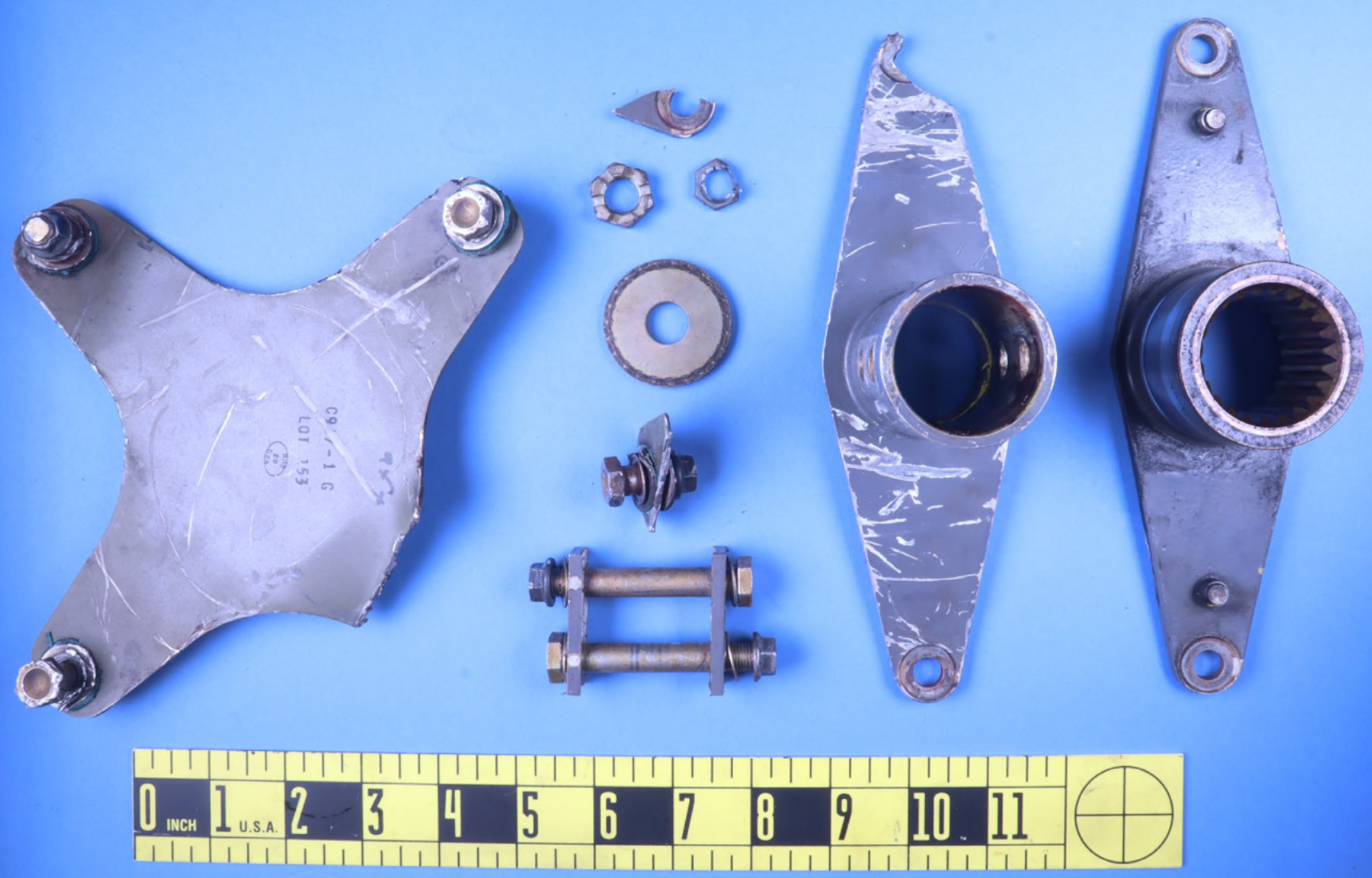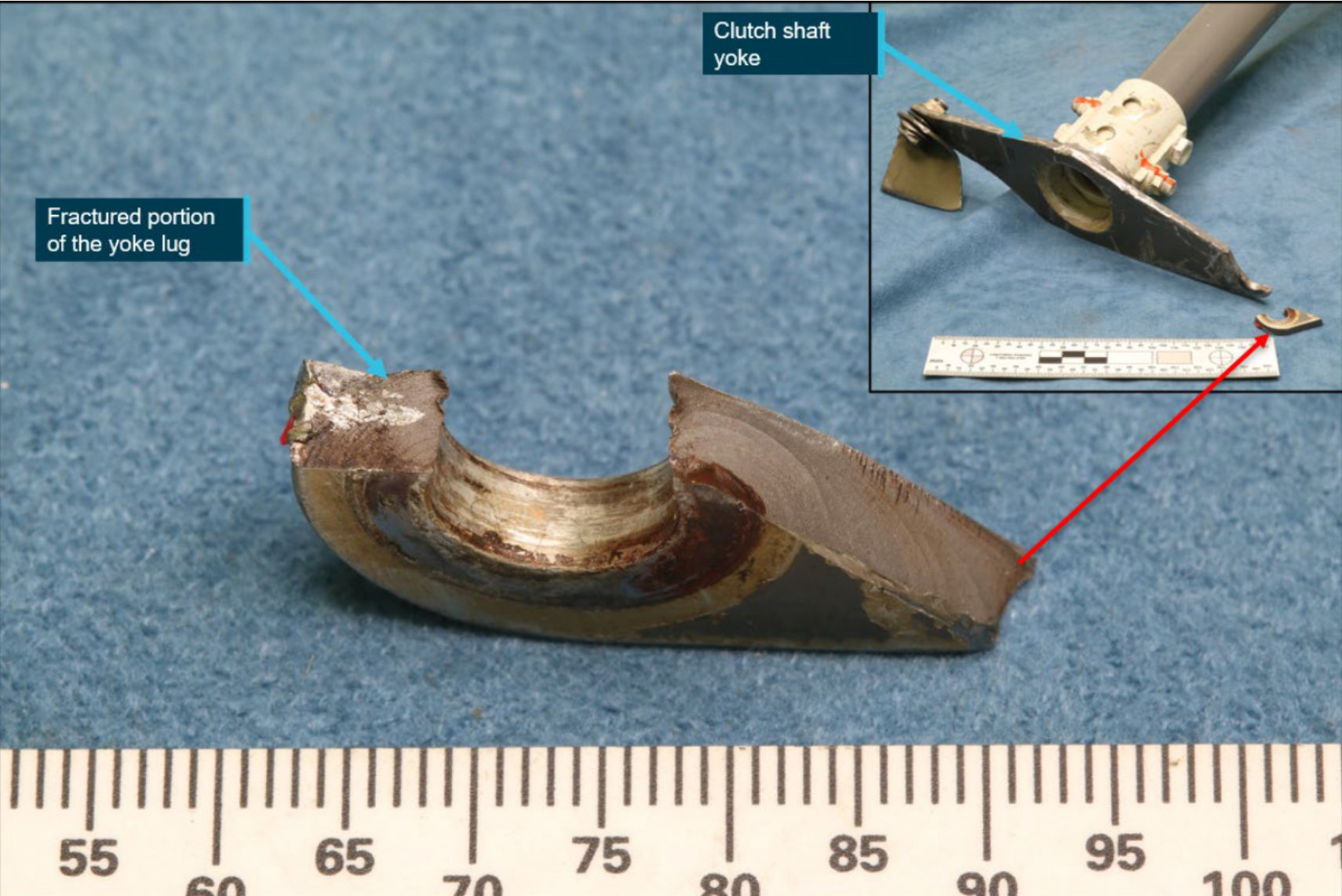NTSB Final Report: North Myrtle Beach, SC
|
Location:
|
North Myrtle Beach, South Carolina
|
Accident Number:
|
ERA22LA256
|
|
Date & Time:
|
May 26, 2022, 13:40 Local
|
Registration:
|
N132TC
|
|
Aircraft:
|
ROBINSON HELICOPTER R44
|
Aircraft Damage:
|
Substantial
|
|
Defining Event:
|
Sys/Comp malf/fail (non-power)
|
Injuries:
|
2 None
|
|
Flight Conducted Under:
|
Part 91: General aviation - Instructional
|
|
|
|
Analysis
Seconds after liftoff to a hover, the helicopter began to “aggressively shudder.” Loud, rapid reports were heard, and the nose of the helicopter yawed to the left. The instructor assumed control of the helicopter, closed the throttle, and performed an autorotation from a hover, landing the helicopter upright on its skids; however, the airframe sustained substantial damage. The instructor completed an engine shutdown, egressed the helicopter, and noticed that the main rotor was still turning while the tail rotor remained stationary. A cursory examination of the helicopter revealed that the clutch shaft yoke fractured at one of its two bolt lugs where the yoke attached to the flex plate. All other damage depicted appeared to be impact damage from the rotating assemblies left unsecured by the fractured lug.
Examination of the damaged yoke and flexplate in the NTSB materials laboratory revealed a fractured attachment lug on the forward clutch shaft yoke due to fatigue failure with multiple origins.
Probable Cause and Findings
The National Transportation Safety Board determines the probable cause(s) of this accident to be: The fractured attachment lug on the forward clutch shaft yoke due to fatigue failure with multiple origins.
Findings
Aircraft Engine/transmission coupling - Fatigue/wear/corrosion
Factual Information
History of Flight
Maneuvering-hover Sys/Comp malf/fail (non-power) (Defining event)
On May 26, 2022, about 1340 eastern daylight time, a Robinson R44 helicopter, N132TC, operated by High Tide Helicopters LLC, was substantially damaged when it was involved in an accident near North Myrtle Beach, South Carolina. The flight instructor and the student pilot were not injured. The helicopter was operated as a Title 14 Code of Federal Regulations Part 91 instructional flight.
According to the flight instructor, the student pilot performed a visual approach, which he terminated at a hover. The student landed the helicopter and then performed a takeoff to a hover. Seconds later, the helicopter began to “aggressively shudder.” Loud, rapid reports were heard, and the nose of the helicopter yawed to the left. The instructor assumed control of the helicopter, closed the throttle, and performed an autorotation from a hover, landing the helicopter upright on its skids. The event resulted in substantial damage to the airframe.
The instructor completed an engine shutdown, egressed the helicopter, and noticed that the main rotor was still turning while the tail rotor remained stationary, and recorded the turning rotor with his telephone. A cursory examination of the helicopter revealed no visible exterior damage and “bits” of engine/transmission drive belts on the runway surface.
A postaccident examination revealed that the clutch shaft yoke fractured at one of its two bolt lugs where the yoke attached to the flex plate. All other damage depicted appeared to be impact damage from the rotating assemblies left unsecured by the fractured lug. The fractured and separated lug piece from the yoke was recovered and retained for further examination, along with the components of the flex plate and yoke assemblies.
Examination of the fractured surfaces of the accident bolt lug by an NTSB materials engineer revealed signatures consistent with fatigue. According to his report, “The fracture faces exhibited contact damage and gross mechanical distortion; however, two fatigue cracks were observed. One fatigue crack nucleated at the bolt hole bore chamfer at the outer periphery on the flex plate side. The fracture faces exhibited contact damage and progressed towards the shaft side of the lug. Fatigue crack progression marks were observed over about 80% of the fracture surface. A second fatigue crack nucleated under the washer of the mounting bolt on the flex plate side of the lug. The crack progressed through the lug thickness towards the shaft side of the lug and outwards towards the free surface of the lug. Fatigue crack progression marks were present over about 90% of the fracture surface.”

Figure 1 Image of the as-received evidence with fractured lug in top center of frame. (NTSB)
Examination of the nucleation sites did not reveal any crack initiation precursors, such as damage, inclusions (foreign object damage), or corrosion. The yoke-to-flex plate clamping surfaces between the attachment hardware, the yokes, and the lugs were clean and presented no paint, primer, or inclusion. The actual torque values applied to the attachment hardware could not be determined.
On June 21, 2021, the Australian Transport Safety Bureau (ATSB) had published a Safety Advisor Notice titled, R44 helicopter drive train failure, in which the circumstances and the damage described and depicted matched that of the accident helicopter.

Figure 2 Fractured Clutch Shaft Yoke (Source: ATSB)
On April 11, 2022, the Federal Aviation Administration published Special Airworthiness Information Bulletin (SAIB), AIR-22-08, Main Rotor Drive System, Tail Rotor Drive System to echo the Australians’ safety concerns and safety message, as such an event had not been reported in the United States or by any U.S. operators before that date.
Pilot Information
|
Certificate:
|
Commercial; Flight instructor;
|
Age:
|
31,Male
|
|
|
Private
|
|
|
|
Airplane Rating(s):
|
Single-engine land
|
Seat Occupied:
|
Left
|
|
Other Aircraft Rating(s):
|
Helicopter
|
Restraint Used:
|
4-point
|
|
Instrument Rating(s):
|
None
|
Second Pilot Present:
|
|
|
Instructor Rating(s):
|
Helicopter
|
Toxicology Performed:
|
|
|
Medical Certification:
|
Class 1 Without
|
Last FAA Medical Exam:
|
December 21, 2021
|
|
|
waivers/limitations
|
|
|
|
Occupational Pilot:
|
Yes
|
Last Flight Review or Equivalent:
|
|
|
Flight Time:
|
(Estimated) 1240 hours (Total, all aircraft), 1048 hours (Total, this make and model), 1150 hours
|
|
|
(Pilot In Command, all aircraft), 167 hours (Last 90 days, all aircraft), 68 hours (Last 30 days, all
|
|
|
aircraft), 1 hours (Last 24 hours, all aircraft)
|
|
Student pilot Information
|
Certificate:
|
Student
|
Age:
|
26,Male
|
|
Airplane Rating(s):
|
None
|
Seat Occupied:
|
Right
|
|
Other Aircraft Rating(s):
|
None
|
Restraint Used:
|
4-point
|
|
Instrument Rating(s):
|
None
|
Second Pilot Present:
|
|
|
Instructor Rating(s):
|
None
|
Toxicology Performed:
|
|
|
Medical Certification:
|
Unknown
|
Last FAA Medical Exam:
|
|
|
Occupational Pilot:
|
No
|
Last Flight Review or Equivalent:
|
|
|
Flight Time:
|
(Estimated) 34.2 hours (Total, all aircraft), 32.2 hours (Total, this make and model), 1.3 hours
|
|
|
(Pilot In Command, all aircraft), 32.2 hours (Last 90 days, all aircraft), 12.3 hours (Last 30 days,
|
|
|
all aircraft), 1 hours (Last 24 hours, all aircraft)
|
|
Aircraft and Owner/Operator Information
|
Aircraft Make:
|
ROBINSON HELICOPTER
|
Registration:
|
N132TC
|
|
Model/Series:
|
R44
|
Aircraft Category:
|
Helicopter
|
|
Year of Manufacture:
|
2002
|
Amateur Built:
|
|
|
Airworthiness Certificate:
|
Normal
|
Serial Number:
|
1259
|
|
Landing Gear Type:
|
Skid
|
Seats:
|
4
|
|
Date/Type of Last
|
May 13, 2022 100 hour
|
Certified Max Gross Wt.:
|
2400 lbs
|
|
Inspection:
|
|
|
|
|
Time Since Last Inspection:
|
30 Hrs
|
Engines:
|
1 Reciprocating
|
|
Airframe Total Time:
|
3711 Hrs at time of accident
|
Engine Manufacturer:
|
Lycoming
|
|
ELT:
|
Installed, not activated
|
Engine Model/Series:
|
O-540 F1B5
|
|
Registered Owner:
|
N132TC LLC
|
Rated Power:
|
260
|
|
Operator:
|
High Tide Helicopters LLC
|
Operating Certificate(s)
|
None
|
|
|
|
Held:
|
|
Meteorological Information and Flight Plan
|
Conditions at Accident Site:
|
Visual (VMC)
|
Condition of Light:
|
Day
|
|
Observation Facility, Elevation:
|
KCRE,29 ft msl
|
Distance from Accident Site:
|
1 Nautical Miles
|
|
Observation Time:
|
13:53 Local
|
Direction from Accident Site:
|
42°
|
|
Lowest Cloud Condition:
|
Clear
|
Visibility
|
10 miles
|
|
Lowest Ceiling:
|
None
|
Visibility (RVR):
|
|
|
Wind Speed/Gusts:
|
9 knots /
|
Turbulence Type
|
/
|
|
|
|
Forecast/Actual:
|
|
|
Wind Direction:
|
110°
|
Turbulence Severity
|
/
|
|
|
|
Forecast/Actual:
|
|
|
Altimeter Setting:
|
30.17 inches Hg
|
Temperature/Dew Point:
|
24°C / 20°C
|
|
Precipitation and Obscuration:
|
No Obscuration; No Precipitation
|
|
|
Departure Point:
|
Southport, NC (SUT)
|
Type of Flight Plan Filed:
|
None
|
|
Destination:
|
North Myrtle Beach, SC
|
Type of Clearance:
|
VFR
|
|
Departure Time:
|
13:00 Local
|
Type of Airspace:
|
Class D
|
Airport Information
|
Airport:
|
Grand Strand CRE
|
Runway Surface Type:
|
Concrete
|
|
Airport Elevation:
|
32 ft msl
|
Runway Surface Condition:
|
Dry
|
|
Runway Used:
|
05
|
IFR Approach:
|
None
|
|
Runway Length/Width:
|
5997 ft / 100 ft
|
VFR Approach/Landing:
|
None
|
Wreckage and Impact Information
Crew Injuries:
|
2 None
|
Aircraft Damage:
|
Substantial
|
|
Passenger
|
N/A
|
Aircraft Fire:
|
None
|
|
Injuries:
|
|
|
|
|
Ground Injuries:
|
|
Aircraft Explosion:
|
None
|
|
Total Injuries:
|
2 None
|
Latitude,
|
33.808099,-78.728463(est)
|
|
|
|
Longitude:
|
|
Administrative Information
|
Investigator In Charge (IIC):
|
Rayner, Brian
|
|
Additional Participating
|
Cornelius Baker; FAA/FSDO; Columbia, SC
|
|
Persons:
|
Thom Webster; Robinson Helicopters; Torrance , CA
|
|
Original Publish Date:
|
March 28, 2024
|
|
Last Revision Date:
|
|
|
|
Investigation Class:
|
Class 3
|
|
Note:
|
The NTSB did not travel to the scene of this accident.
|
|
Investigation Docket:
|
https://data.ntsb.gov/Docket?ProjectID=105177
|
|
|
|
|
The National Transportation Safety Board (NTSB) is an independent federal agency charged by Congress with investigating every civil aviation accident in the United States and significant events in other modes of transportation— railroad, transit, highway, marine, pipeline, and commercial space. We determine the probable causes of the accidents and events we investigate, and issue safety recommendations aimed at preventing future occurrences. In addition, we conduct transportation safety research studies and offer information and other assistance to family members and survivors for each accident or event we investigate. We also serve as the appellate authority for enforcement actions involving aviation and mariner certificates issued by the Federal Aviation Administration (FAA) and US Coast Guard, and we adjudicate appeals of civil penalty actions taken by the FAA.
The NTSB does not assign fault or blame for an accident or incident; rather, as specified by NTSB regulation, “accident/incident investigations are fact-finding proceedings with no formal issues and no adverse parties … and are not conducted for the purpose of determining the rights or liabilities of any person” (Title 49 Code of Federal Regulations section 831.4). Assignment of fault or legal liability is not relevant to the NTSB’s statutory mission to improve transportation safety by investigating accidents and incidents and issuing safety recommendations. In addition, statutory language prohibits the admission into evidence or use of any part of an NTSB report related to an accident in a civil action for damages resulting from a matter mentioned in the report (Title 49 United States Code section 1154(b)). A factual report that may be admissible under 49 United States Code section 1154(b) is available here.
READ MORE ROTOR PRO: https://justhelicopters.com/Magazine
WATCH ROTOR PRO YOUTUBE CHANNEL: https://buff.ly/3Md0T3y
You can also find us on
Instagram - https://www.instagram.com/rotorpro1
Facebook - https://www.facebook.com/rotorpro1
Twitter - https://twitter.com/justhelicopters